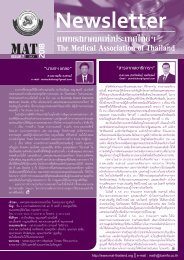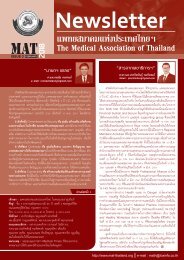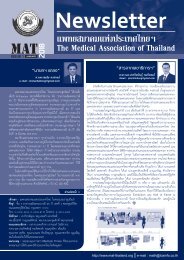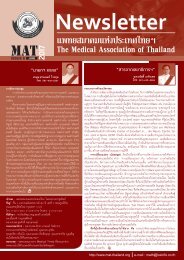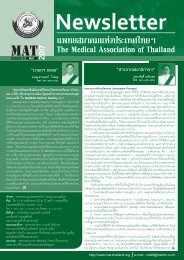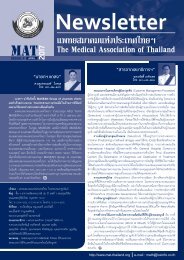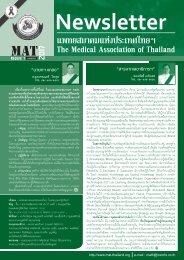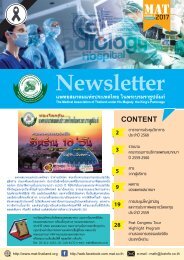risk factor for preeclampsia
Create successful ePaper yourself
Turn your PDF publications into a flip-book with our unique Google optimized e-Paper software.
Pre-Eclampsia Risk Factors and Adverse Outcomes<br />
care that are more prevalent in less developed regions require<br />
further investigation and validation of findings [8–10]. In addition,<br />
previous research has been limited by small sample sizes [11] or<br />
analytic methods that do not properly take into account the effects<br />
of higher-level <strong>factor</strong>s [12,13].<br />
As <strong>for</strong> pre-eclampsia’s adverse maternal and perinatal outcomes,<br />
there is limited in<strong>for</strong>mation and research assessing the<br />
magnitude of <strong>risk</strong>s in low-resource areas where the impact is<br />
thought to be more severe [14]. Furthermore, small sample sizes<br />
or lack of adjustment <strong>for</strong> some important confounders are notable<br />
weaknesses that have restricted previous research [11,15].<br />
This study thus aimed to conduct multi-level analyses of data<br />
from the WHO Global Survey on Maternal and Perinatal Health<br />
including 23 developing countries in Africa, Latin America and<br />
Asia in order to estimate associations between maternal, country<br />
characteristics and pre-eclampsia/eclampsia, and to estimate the<br />
magnitude of <strong>risk</strong>s <strong>for</strong> pre-eclampsia/eclampsia’s adverse maternal<br />
and perinatal outcomes.<br />
Methods<br />
Ethics Statement<br />
The protocol was approved by the WHO’s Scientific and<br />
Ethical Review Group and Ethics Review Committee and that of<br />
each country independently [16]. Written consent was obtained<br />
from each participating country’s ministry of health and each<br />
selected facility’s director [16]. Because the study involved clusterlevel<br />
inclusion and records data extraction without individual<br />
identifying in<strong>for</strong>mation, individual in<strong>for</strong>med consent was not<br />
obtained.<br />
Study design<br />
We undertook a secondary analysis of the WHO Global Survey<br />
on Maternal and Perinatal Health. Details of this survey’s<br />
methodology are available elsewhere [16]. To summarize, the<br />
survey was a multi-country, facility-based cross-sectional study. It<br />
was conducted between 2004 and 2005 in Africa and Latin<br />
America, and between 2007 and 2008 in Asia. A global sample of<br />
countries and health facilities was obtained via a stratified<br />
multistage cluster sampling design. Twenty-four countries from<br />
three regions were included in the survey: Algeria, Angola,<br />
Democratic Republic of Congo, Niger, Nigeria, Kenya, and<br />
Uganda from Africa; Argentina, Brazil, Cuba, Ecuador, Mexico,<br />
Nicaragua, Paraguay, and Peru from Latin America; and<br />
Cambodia, China, India, Japan, Nepal, Philippines, Sri Lanka,<br />
Thailand, and Vietnam from Asia. For each country, the capital<br />
city and two randomly selected provinces were included in the<br />
sample. Only health facilities with caesarean section (C-section)<br />
capacities and with reported annual deliveries of at least 1,000<br />
were eligible <strong>for</strong> inclusion. Up to seven facilities per country were<br />
randomly selected. A total of 373 facilities were included in the<br />
survey. The recruitment and data collection period varied<br />
depending on the volume of deliveries in the sampled facilities.<br />
Specifically, it was set <strong>for</strong> three months <strong>for</strong> facilities with up to<br />
6,000 annual deliveries and two months <strong>for</strong> those with more than<br />
6,000 annual deliveries. All pregnant women admitted <strong>for</strong> delivery<br />
during the recruitment period were included.<br />
Data Sources<br />
Data <strong>for</strong> individuals and institutions were sourced from the<br />
WHO Global Survey on Maternal and Perinatal Health.<br />
Individual data were obtained via direct extraction from patient<br />
records by trained medical personnel within seven days after<br />
delivery or be<strong>for</strong>e maternal hospital discharge. Institutional data<br />
were collected using a standard <strong>for</strong>m by hospital coordinators in<br />
consultation with the director or head of obstetrics, and country<br />
in<strong>for</strong>mation was obtained from the World Bank [17] and literature<br />
[18].<br />
Main Outcomes Variable Definitions<br />
Due to secondary data limitations and based on previous<br />
research [13] pre-eclampsia and its complication, eclampsia, were<br />
combined into a single outcome variable. Pre-eclampsia was<br />
defined as high blood pressure ($140 mmHg systolic or<br />
$90 mmHg diastolic, or increases of 30 mmHg systolic or<br />
15 mmHg diastolic from the baseline on at least two occasions<br />
six or more hours apart) that develops from the 20 th gestational<br />
week in a previously normotensive woman, and proteinuria. The<br />
outcome can be based on having the recorded diagnosis or on<br />
blood pressure and urine test findings, even without specifying the<br />
condition. Eclampsia was defined as the onset of convulsions<br />
described as grand-mal type seizures first appearing be<strong>for</strong>e or<br />
during labour, or within 48 hours from delivery, and/or coma<br />
unrelated to other cerebral conditions in women with preeclamptic<br />
signs and symptoms.<br />
Adverse maternal and perinatal outcomes including maternal<br />
death, perinatal death, preterm birth and low birthweight were<br />
investigated. Maternal death was defined as intrahospital death of<br />
a woman that occurred on or be<strong>for</strong>e the 8 th day postpartum.<br />
Perinatal death was defined as early neonatal death (i.e.<br />
intrahospital death of an infant that occurred on or be<strong>for</strong>e the<br />
7 th day after delivery) or stillbirth (fresh or macerated). Preterm<br />
birth was defined as livebirth occurring at less than 37 completed<br />
gestational weeks and low birthweight was defined as birthweight<br />
,2500 grams of a liveborn infant regardless of gestational age.<br />
Independent Variables Definitions<br />
The individual characteristics investigated were: maternal age,<br />
marital status, maternal educational level, maternal body mass<br />
index (BMI), parity, maternal clinical conditions (chronic hypertension,<br />
gestational diabetes, cardiac/renal disease, pyelonephritis<br />
or urinary infection, severe anemia) and number of antenatal<br />
visits. Maternal age was defined as age in completed years at the<br />
time of delivery. Participants were classified into four categories:<br />
,20, 20 to 29, 30 to 34 and $35 years. Marital status was<br />
dichotomized into single/widowed/divorced/separated and married/cohabiting<br />
with the infant’s father. Maternal education was<br />
based on the number of years of schooling. The UNESCO<br />
international standard classification of education was adopted<br />
allocating participants to one of five levels: no education (0 years),<br />
primary (1 to 6 years), lower secondary (7 to 9 years), upper<br />
secondary (10 to 12 years) and post-secondary/tertiary (.12<br />
years).<br />
Maternal BMI was computed as the ratio of maternal weight in<br />
kilograms and the square of maternal height in meters. In Africa<br />
and Latin America, maternal weight was recorded at the last<br />
antenatal care visit, while in Asia, it was recorded at admission <strong>for</strong><br />
delivery. Maternal BMI was categorized into four ranges: ,20, 20<br />
to ,26, 26 to ,35 and $35 kg/m 2 . Parity was defined as the<br />
number of previous births and was dichotomized into nulliparity<br />
and multiparity. Maternal clinical conditions were determined<br />
based on the recorded diagnosis or laboratory findings, even<br />
without specifying the condition. Chronic hypertension was<br />
defined as high blood pressure diagnosed prior to the onset of<br />
pregnancy or be<strong>for</strong>e the 20 th gestational week. Severe anemia was<br />
defined as a haemoglobin level of ,7 g/dL during pregnancy.<br />
The number of antenatal visits was irrespective of whether the<br />
antenatal clinic was different from the admission facility. This was<br />
PLOS ONE | www.plosone.org 2 March 2014 | Volume 9 | Issue 3 | e91198




